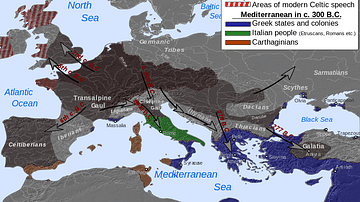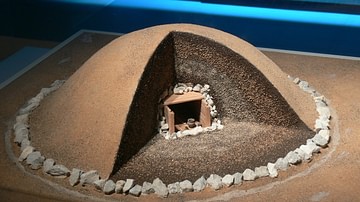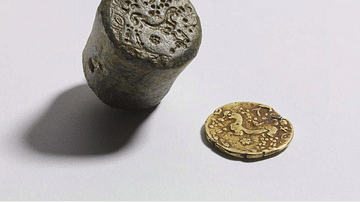Search
Search Results

Article
Epona
Epona was a Celtic goddess. Her name contains an allusion to the horse: in Celtic, "epos" means “horse” and the suffix “-ona” affixed simply means “on”. Epona is the patron goddess of mares and foals. The oldest information about the Gallic...

Definition
Lugh
Lugh (also Lug, Luga) was one of the most important Celtic gods, particularly in Ireland, and he represented the sun and light. Although originating as an all-wise and all-seeing deity, Lugh was later thought of as a historical figure, great...

Image
Map of Celtic Expansion - 6th-3rd century BCE
A map showing the various campagins of Celtic tribes between the 6th and 3rd centuries BCE.

Image
Map of Celtic Peoples in the Post-Classical Period
A map showing the spread of Celtic-speaking peoples in Europe, and their migrations in the Post-Classical Period.

Image
Celtic Deity, Gundestrup Cauldron
A detail of the Gundestrup cauldron, a gilded silver vessel showing imagery of Celtic-inspired gods. Likely 1st century BCE, produced in the Balkans but found in Denmark in 1891 CE. (National Museum of Denmark, Copenhagen)

Image
Celtic Tripartite Vessel
A Celtic tripartite carinated pottery vessel. These vessels are made from three separate pieces, each with straight sides, which when assembled create an angular form. This example was found in a grave in the Marne region of northern France...

Image
Celtic Burial Mound Reconstruction, Hallstatt
A reconstruction of a Celtic burial mound from the Hallstatt culture of Austria and central Europe in the 1st millennium BCE. (German National Museum, Nuremberg)

Image
Figures & Head Columns from Celtic Roquepertuse
Seated figures and stone columns with niches for human heads or skulls from a Celtic religious site at Roquepertuse, France. 3rd century BCE. (Musée d'histoire, Marseille, France)

Image
Celtic Coin Die & Gold Coin
A Celtic coin die and gold coin showing a horse design from Bredgar, Kent, England, 2nd century BCE.
The British Museum, London.

Image
Celtic Burial Mounds
Reconstructions of Celtic burial mounds dating to the La Tène period (5th to 1st century BCE). The mounds were surrounded by circular ditches of 0.6 metres and 1.2 metres. European Archaeological Park of Bliesbruck-Reinheim, Germany / France...